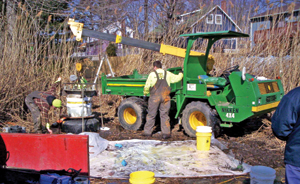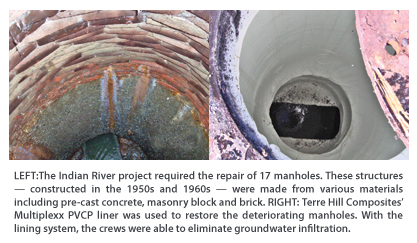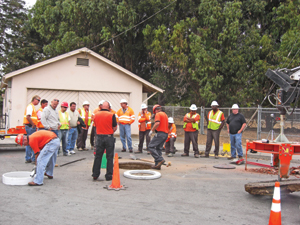Adapting to the Environment
April 1, 2009
 Every type of project has its own set of challenges and risks that need to be addressed before any work can be done. Whether it’s a problematic location or strict government regulations, contractors and their crews must design a plan of attack to achieve positive results.
Every type of project has its own set of challenges and risks that need to be addressed before any work can be done. Whether it’s a problematic location or strict government regulations, contractors and their crews must design a plan of attack to achieve positive results. For the City of Milford, Conn., Indian River Interceptor Manhole Rehabilitation Project, overcoming obstacles in difficult terrain was essential to its success. By adapting to the jobsite’s surroundings and discovering ways to continue work in winter months, crews were able to repair the damaged structures — leading to a better and more cost-efficient wastewater system.
Identifying the Problem
In 2005 Westcott and Mapes, a Connecticut-based engineering consulting firm, performed a sewer system evaluation survey (SSES) for the City of Milford, Conn., Sewer Commission. The company was to investigate the sources of inflow-and-infiltration (I/I) to the city’s wastewater collection system.
“In our investigation, we were able to narrow down the locations of the sources of I/I,” says Westcott and Mapes chief engineer Ray Paier. “It was determined that the manholes in the Indian River basin area were a major source of I/I.”
By the end of the investigation, Westcott and Mapes found 17 manholes in need of attention. These structures were constructed in the late 1950s and early 1960s — made from various materials including pre-cast concrete, masonry block and brick. The manholes were all 4-ft inside diameter with varying irregularities and shapes and ranged in depth from 8 to 16 ft, with an average depth of 11 ft.
Due to the location and structural integrity of the manholes, rehab was the most practical and cost-effective plan. From there, Westcott and Mapes prepared bidding documents and began the search for a contractor in spring 2007. Terre Hill Composites, a leading manufacturer of cured-in-place manhole (CIPM) products, based in Ephrata, Penn., was chosen. Under the contract, the company would use its Mutiplexx PVCP CIPM lining system to restore the deteriorating manholes. Terre Hill was also contracted to install 4-ft high, 8-in. thick concrete grade rings to four of the manholes, set new frames and covers and to re-cement and waterproof all of the exposed above-grade manhole exteriors
“With our PVCP manhole lining system, we guarantee the elimination of infiltration, not just the control or managing of it,” says Bill Oberti, vice president and general manager of Terre Hill Composites (THC). “With the PVCP liner, all sewer gas induced corrosion is also eliminated and the owner is given a 10-year, non pro-rated warranty to back this up.”
Getting to Work
Due to the severity of the site conditions, Terre Hill reached out to its Midwest installer, Paradise Eco Solutions (PES); it had worked with Terre Hill before in extreme conditions and was familiar with such challenges due to its 10-plus years of experience. Terre Hill crews would do the preliminary and finish work, while PES focused on the lining with THC support.
The location of the manholes caused significant challenges to the crews. Nestled in Indian River basin, the manholes were surrounded by a marshland environment and the tidally influenced water of the river — making access an issue. The rising tide made the ground around the manholes too soft, causing workers and their equipment to sink.
To sidestep this problem, a wintertime installation was scheduled for January 2008 — the coldest time of the year. This way, the ground would be hard enough for crews to access the manholes along with the equipment they needed. It was also a time of the year where plant growth was dormant, so the crews were not impacting any blooming vegetation.
But the plan wasn’t completely fool-proof. With the tide continuing to rise and saturate the earth, the water was still warm enough to thaw the ground; this led to crews working around the tide’s schedule to avoid the river and softer soils.
“Onsite we quickly found out that we had a limited window for work, which was based on when the tide rose,” says Oberti. “The water from the tide would thaw the frozen marshland from below, and when the sun was rising, this would start thawing the ground from above. So, we needed to be right on schedule with the tides and try to beat the sun. We made sure to look at the daily tide reports, and every day the impact of the tide would shift about 40 minutes.”
 Since the marshland posed such difficult access and movement, the project required some specialized vehicles and machinery to transport the equipment needed for installation. One particular piece was called the FROG (Finds Remote Objects Gracefully). The FROG is a four-wheel-drive tractor equipped with 36-in. wide balloon tires and a crane.
Since the marshland posed such difficult access and movement, the project required some specialized vehicles and machinery to transport the equipment needed for installation. One particular piece was called the FROG (Finds Remote Objects Gracefully). The FROG is a four-wheel-drive tractor equipped with 36-in. wide balloon tires and a crane. “The vehicle distributed the load evenly on the marsh, so we wouldn’t get stuck in soft soils,” says Oberti. “The crews couldn’t have done this project with a typical installation box truck or a truck-and-trailer set-up, because they wouldn’t have been able to get in and out of the locations that we had to deal with.
“PES used the FROG not only to transport the equipment we needed to install the liners, but with its on-board crane and the room to mount installation equipment they were able to use it for complete installations.”
Other vehicles and machinery that were used included a boat to cross the river and bring materials to and from manhole access points and a backhoe in areas that were easily accessible such as the manholes near streets.
After access issues were taken care of, work on the manholes could finally begin. Before crews could line the manholes, they first had to use chemical grout to stop all of the groundwater leaks in the structures. Since they were working in freezing temperatures, the workers had to winterize the equipment they needed for the lining process.
“We prefer not to line in extreme cold, because it can lead to issues with our equipment, not to mention the very real human element for the crews” says Oberti. “Since we run water for the curing process, the winterization assures us that the water will not freeze in any of the lines. Plus our onboard equipment, like generators and boilers are diesel-run, so we have to be careful about using proper additives so the fuel doesn’t gel up.”
As for the actual liner, crews also had to take extra steps to make sure it was installed properly. The epoxies that were used had to be preheated because the materials get extremely viscous in the cold. The preheating was accomplished by soaking the epoxy buckets in hot water baths and applying it to the liner once it was warmed up. Then the liner had to be put into the ground immediately. Once the liner was in the ground, the ambient temperatures in the manholes — around 50 degrees — offered proper working temperatures to inflate and cure the liners. In CIPM, constant air pressure is used to force the epoxy into the substrate and keep it there while super-heated water is introduced to accelerate the curing process. This is a key difference of CIPM to other topical repair methodology. (Such topical systems actually cure in tension away from the substrate.)
Each manhole took about six hours to complete between prep time, dealing with infiltration and installing the liners. The Milford Indian River Basin project and all 17 of the manholes were successfully completed in March 2008.
During a post-construction inspection conducted by Westcott and Mapes in fall 2008, all of the liners were intact and all of the inflow to the system from the manholes was successfully stopped.
Pam Stask is an assistant editor of Trenchless Technology.
Manholes Done Right!
 Union Sanitary District, located in Union City Ca., is an industry leader in locating and utilizing the latest technologies to maximize worker safety and efficiency. The district acquired the Mr. Manhole tools and training to speed the removal and replacement of manhole frames and lids in 2008. The Mr. Manhole system enables the removal of a manhole frame from the road in just minutes with no manual labor. The equipment operates on a skid steer which most municipal groups already have in their fleet. After removing the manhole frame it can be rebuilt quickly using the Mr. Manhole rebuilding system. The system is fully engineered and is always perfectly level with the road surface. The Mr. Manhole system reduces I and I by totally stopping leakage in the chimney section of the manhole. The Union Sanitary District is systematically removing and replacing its manhole frames. The replacements have a return on investment time of a little over two years and keep paying dividends for the life of the structure due to treatment cost savings. The Mr. Manhole system can be viewed online at www.mrmanhole.com.
Union Sanitary District, located in Union City Ca., is an industry leader in locating and utilizing the latest technologies to maximize worker safety and efficiency. The district acquired the Mr. Manhole tools and training to speed the removal and replacement of manhole frames and lids in 2008. The Mr. Manhole system enables the removal of a manhole frame from the road in just minutes with no manual labor. The equipment operates on a skid steer which most municipal groups already have in their fleet. After removing the manhole frame it can be rebuilt quickly using the Mr. Manhole rebuilding system. The system is fully engineered and is always perfectly level with the road surface. The Mr. Manhole system reduces I and I by totally stopping leakage in the chimney section of the manhole. The Union Sanitary District is systematically removing and replacing its manhole frames. The replacements have a return on investment time of a little over two years and keep paying dividends for the life of the structure due to treatment cost savings. The Mr. Manhole system can be viewed online at www.mrmanhole.com. Testimonial from Tom Herlihy (Union Sanitary District)
“Our organization never stops looking for the safest, most accurate, and efficient means of doing business. We consider innovation and technology to be an integral part of our overall “work smarter” business strategy. As part of this, we have been witness to many manufacturers whom make outlandish claims about how well their products perform. Yet, every now and again, we encounter one that not only lives up to its billing, but actually exceeds our expectations.
After watching the online video and talking to a sales rep, I remained skeptical and indicated at the time that if it worked half as well as advertised, then our organization would likely be very interested. What we saw was a demonstration that rendered all 25 or so nearly speechless. With my own two eyes, I witnessed a 27” manhole being cut out, removed in one piece (grade rings and all), reset, and finished to grade with the tolerance of a paper business card in less than an hour. First you accomplished it with your 2 employees, but then repeated it with two of our guys and the results, basically identical! Wow!!!
The Mr. Manhole system truly is one of those unique products that delivers value at every conceivable level. So if the idea of increasing profits, lowering risks, and improving quality appeal to you, then I guess that the next step is up to you. Adjusting iron in the San Francisco Bay Area will never be the same. Keep up the good work!”
